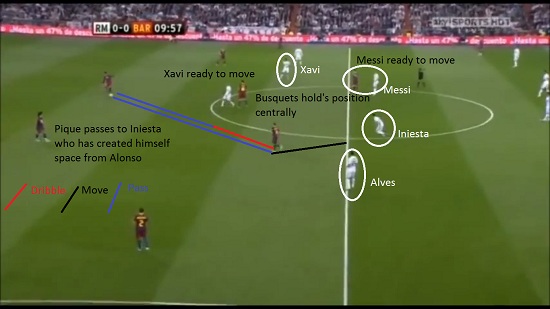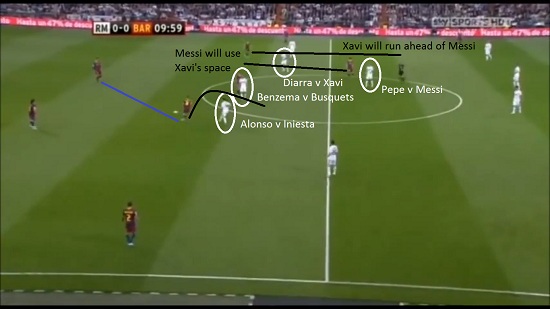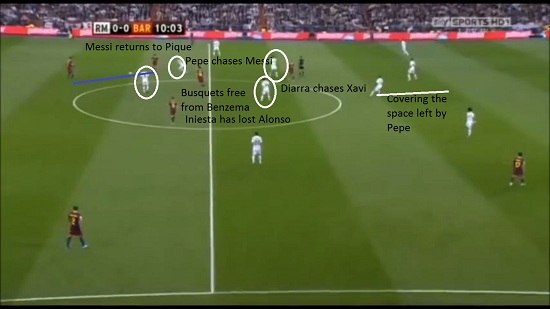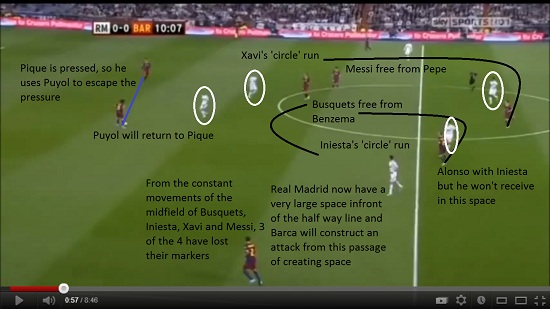By Stevie Greive

As the ball is returned to Pique, Iniesta checks his run for the 4th time! This time, as Alonso is too far away, he wont be able to press effectively and stop Iniesta receiving with ease. Iniesta dribbles back then passes back to Pique, then circles round the back of Alonso. Xavi is ready to make his circle run, and when he does, Messi will fill in his space (positional rotation).
Note the Real Madrid players circled and who they are supposed to be marking – Diarra (Xavi) Pepe (Messi) Alonso (Iniesta) and Di Maria (Alves). Only Pepe is within pressing distance and even here, Messi is only holding Pepe in position, and not getting involved.
Circle your opponents to open a space

Iniesta has Alonso on his back, so he passes back to Pique, then arc’s around Busquets, using him as a blocker on Alonso. Xavi has run ahead of Diarra, Messi has dropped into Xavi’s space at the same time. Diarra has followed Xavi to Pepe’s space, as Pepe chases Messi. If Pepe and Diarra stay in shape, Xavi and Messi would simply stop their runs and play between 2 or 3 players and when they receive, open up a space in the system, so Real Madrid make sure that they both follow their opponents.
Why does circling the opponents help? It’s a movement that can create space in a medium sized space for 1v1 situations, or to create space for a team mate (Here, Messi) in a compact space, in a 2v2, 3v3 or 4v4 scenario. This movement looks like it has been practised as a set rotational pattern like in a Futsal match.
Using the space to receive the ball

As Messi drops in to receive, he passes back. Simple, yet effective. Real Madrid don’t want to chase down Pique and Puyol, they want to keep the ball with these 2 and stop Busquets, Xavi, Iniesta and Messi receiving in space around the half way line. Note how far advanced Pique now is, around 30 yards closer to the half way line, forcing Madrid deeper. Note that the previous 2-3-1 defensive shape inside the Barcelona half is now a 2-2-2 shape, but with Busquets inside a box of 4 players, and with Iniesta just outside the square able to receive if possible. Watch Xavi continue his circle run into Messi’s space, with Iniesta circling Alonso.
Using the space to build the attack in space

Pique uses Puyol as his ‘get out of trouble’ pass. Xavi has circled round into the top of the diamond, with Messi now free from pressure, as Pepe is unsure to chase the ball or not. Busquets picks up his usual position inside the centre circle at the bottom of the diamond, able to dictate play with 1 or 2 touch passes. Busquets is free of a marker, Messi is free of Pepe, Xavi is free from Diarra – he plays between Alonso and Diarra - and Iniesta is being marked by Alonso.
Clever, perhaps pre-planned movements have allowed Xavi, Messi and Busquets to all find space in what was previously a 2-3-1 compact midfield, now is a 2-2-2 midfield with a massive hole in the centre of the structure. Pepe is 15 yards away from the centre spot area where he should be just now, covering Diarra’s movement with Xavi.
Controlling the Midfield

Now that Puyol returns to Pique, Pique has 2 clear passes into midfield, unopposed. He uses Xavi who knows that Busquets will anticipate Xavi will lay the ball off 1st time to him in space, where he can see he is free. Messi runs central again, pulling Diarra more central and this allows Messi to occupy 2 defenders. Alonso has moved over to take responsibility for Messi – this allows Iniesta to be free for the pass from Busquets if he wants to penetrate the midfield line.
By Stevie Greive - Pro Academy Coach - Stevie Grieve is the author of "Sergio Busquets - Barcelona's Unsung Hero", which we give away as a free bonus with the purchase of our Barcelona book. Stevie is currently writing a book on tactical observations similar to this article. The tactical observations are based on games played by the world's top teams like Barcelona, Real Madrid, Manchester United, Arsenal, etc. as well as articles that focus on certain players. This book is planned for the summer 2012.


